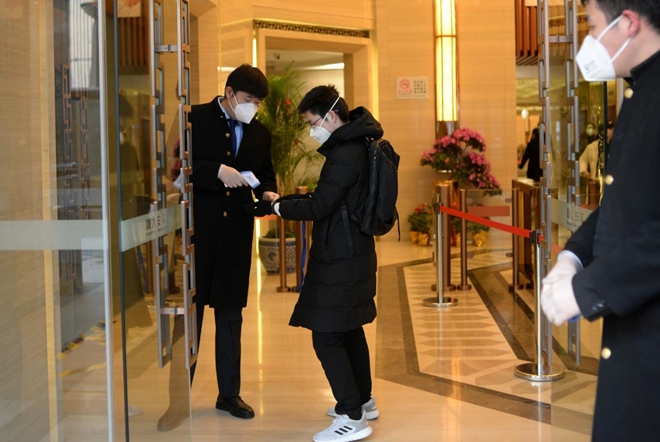Nearly 100 more die from coronavirus in China, workers start to return to offices and factories
 |
|
Jin Yang, 28, who works in a department of China's State Administration of Foreign Exchange, receives temperature check at an entrance to his company, in the morning on his first day of returning to work after the extended Lunar New Year holiday caused by the novel coronavirus outbreak, in Beijing, China February 10, 2020. REUTERS/Tingshu Wang |
The death toll from the epidemic rose to 908, all but two in mainland China, on Sunday as 97 more fatalities were recorded - the largest number in a single day since the outbreak was detected in the Chinese city of Wuhan in December.
The Diamond Princess cruise ship with 3,700 passengers and crew onboard remained quarantined in the Japanese port of Yokohama, with 60 more cases detected, taking the number of confirmed case from the Carnival Corp-owned vessel to 130.
On the economic front, stocks and oil fell in global markets while safe-haven gold rose.
Across mainland China, 3,062 new infections were confirmed on Sunday, bringing the total number to 40,171, according to the National Health Commission (NHC).
Wu Fan, vice-dean of Shanghai Fudan University Medical school, said there was hope the spread might soon reach a turning point.
“The situation is stabilising,” she told a briefing when asked about the spread in Shanghai, which has had nearly 300 cases and one death.
But WHO chief Tedros Adhanom Ghebreyesus, speaking in Geneva, said there had been “concerning instances” of transmission from people who had not been to China.
“The detection of a small number of cases may indicate more widespread transmission in other countries; in short, we may only be seeing the tip of the iceberg,” he said.
The virus has spread to at least 27 countries and territories, according to a Reuters count based on official reports, infecting more than 330 people. The two deaths outside mainland China were in Hong Kong and the Philippines.
The death toll from the outbreak has now surpassed that of another coronavirus, Severe Acute Respiratory Syndrome (SARS), which brought a global epidemic in 2002/2003.
NERVOUS COMMUTERS
The epidemic has caused huge disruptions in China with usually teeming cities becoming virtual ghost towns after Communist Party rulers ordered lockdowns, cancelled flights and closed factories and schools.
Ten extra days had been added to the Lunar New Year holidays that had been due to finish at the end of January. But even on Monday, many workplaces remained closed and many people worked from home.
Few commuters seen during the morning rush-hour on one of Beijing’s busiest subway lines. All were wearing masks.
Jin Yang, who works in a department of China’s State Administration of Foreign Exchange, rode a bicycle to work instead of public transport. Staff were told to wear masks, avoid face-to-face meetings and the canteen was closed.
Another employee surnamed Chen said the insurance company he worked for had barred people from taking public transport.
“I usually take subways but this morning it cost me 200 yuan one way by cab,” he said.
One Beijing government official, Zhang Gewho, said it would be be harder to curb the spread of the virus as people returned to work and efforts to combat it had entered a critical period.
“Beijing will see an influx of people returning to the city. The capacity of communities and flow of people will greatly increase and the difficulty of virus prevention and control will further rise,” he said.
Hubei, the province of 60 million people that is the hardest hit by the outbreak, remains in virtual lockdown, with its train stations and airports shut and its roads sealed.
The extended closure of factories in the world’s second-largest economy has raised concerns about disruptions cascading through global supply chains.
The coronavirus is also a huge test for President Xi Jinping, who has largely kept out of the spotlight, leaving Premier Li Keqiang to take the public lead in government efforts to control the outbreak.
On Monday, Xi appeared among the public for the first time since the outbreak mushroomed, and was shown by state television inspecting the work of community leaders in Beijing, and wearing a mask as he had his temperature taken.
In Britain, the government said on Monday the number of confirmed coronavirus cases there had doubled to eight and it declared the virus a serious and imminent threat, giving it additional powers to isolate those suspected of being infected.
Much remains to be determined about the virus, which has been linked to a market selling animals in Wuhan, the capital of Hubei province, including how easily it spreads and how deadly it is. Chinese researchers found that its incubation period could be up to 24 days. It had been thought to be up to 14 days.
China’s central bank has taken a raft of steps to support the economy, including reducing interest rates and flushing the market with liquidity. From Monday, it will provide special funds for banks to re-lend to businesses.
Taiwan’s Foxconn has received Chinese government approval to resume production at a plant in the north China city of Zhengzhou, a source with direct knowledge of the situation told Reuters on Monday. But the southern city of Shenzhen rejected a company request to resume work at a plant there.

